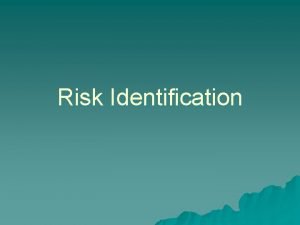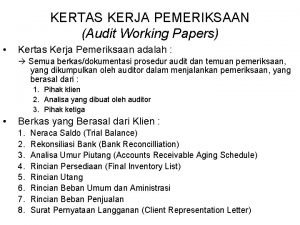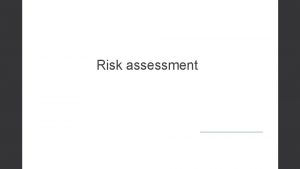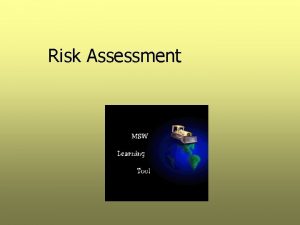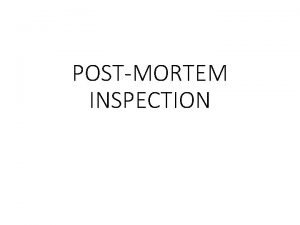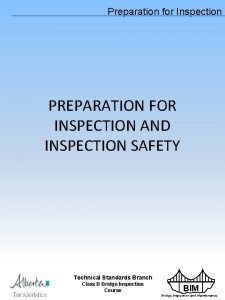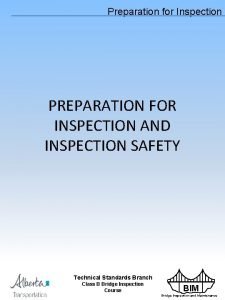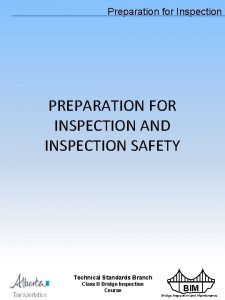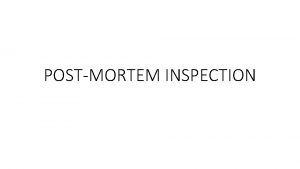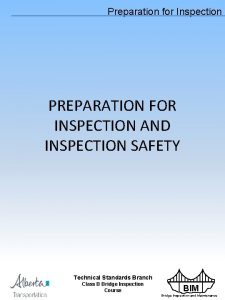3 Inspection Schedule Risk Assessment 1 Inspection Schedule










- Slides: 10

3. Inspection Schedule & Risk Assessment 1 Inspection Schedule & Risk Assessment • Who is eligible for smallholder group certification? Can bigger farms be certified in a smallholder group? • Risk assessment to confirm risk categories and related minimum re-inspection rates. • Other considerations (project sites, ICS centers, witness audits, etc. ) to plan an efficient ICS inspection schedule. • Focus on critical control points Training Manual on the Evaluation of Internal Control Systems

3. Inspection Schedule & Risk Assessment 2 What is a Smallholder? 1. 1 To be considered a “smallholder” for smallholder group certification, the following should be fulfilled: Smallholder or not? • The cost of individual certification must be disproportionately high in relation to sales value (>2% of sales). • In addition, at least 3 out of 5 of the following requirements must be fulfilled: • Average income lower than app. US$5000/yr • Farm units are managed mainly by family labor • Low-tech production system • Limited capacity to market on his/her own • Limited capacity for storage/processing Attention: The EU guidance document restricts smallholder group certification to developing countries only (as defined by OECD) Training Manual on the Evaluation of Internal Control Systems

3. Inspection Schedule & Risk Assessment 3 Other Requirements for Group Certification 1. 2 Within the group there is homogeneity of members in • geographical location • production system • size of holding 1. 3 Common marketing system for the group Training Manual on the Evaluation of Internal Control Systems

3. Inspection Schedule & Risk Assessment 4 Group Certification Options for bigger Farms Groups NOT qualified as smallholder group • can still be certified as an organized group of growers • can have assistance in documentation, joint marketing • must have common marketing system • each member farm has to be inspected by the certification body and has to keep its own documentation 4. 3. 4 Farms (bigger than “smallholders”) are certified as part of a smallholder group • Each farm is inspected annually by both the ICS and the certification body. • Each farm has to keep most farm documentation for itself • Common marketing under responsibility of the ICS Operator (no farmer marketing his/her own farm) Training Manual on the Evaluation of Internal Control Systems

3. Inspection Schedule & Risk Assessment 5 4. 1 Risk Assessment by the ICS Operator • A detailed initial risk assessment has to be done at the beginning of certification (first year of certification or when informed about this requirement by certifier). Farmer harvests • Quality aspects (ripe) • Use of pesticides against ants • Any protection against insects, other animals • Use of inputs in intercrops • Contaminated picking bags • Mixing org. -buffer zone crops • Has to identify internal and external risks at farm level as well as during buying, processing, or (export) transport, while the product is under the responsibility of the ICS Operator. Packing/storage at farm Drying at farm • Pest protection drying yard • Hygienic contamination • Product quality • Commingling (dry product of other farms, joint drying) • Contamination (drying at road, close to spraying farmer, malaria prevention program) • Use of any ingredients/auxiliaries • Contaminated bags • Labeled • Commingling with last year’s product stock (other status) • Product quality • Storage pest control Tool: Risk checklist in ICS Guidance Manual Training Manual on the Evaluation of Internal Control Systems

3. Inspection Schedule & Risk Assessment 6 Sample Risk Assessment by the ICS See Appendix to the ICS Set Up Guidance Manual p. 5 Training Manual on the Evaluation of Internal Control Systems

3. Inspection Schedule & Risk Assessment 7 Risk Assessment by the Certifier CERTIFIER: PRELIMINARY RISK ASSESSMENT • Based on information from the project • Based on knowledge of the crop, typical situation in the specific region, similar operators • Needed to estimate necessary external re-inspection rate INSPECTOR: RISK ASSESSMENT & CRITICAL CONTROL POINTS • Based on internal risk assessment and overall inspection findings (ICS visit, farm inspections) • Rather simple risk assessment in report (chapter 4. 2) to determine minimum external control rate for authorities • In addition to this formal risk assessment, inspectors should constantly think about potential risks and concentrate on these critical control points Training Manual on the Evaluation of Internal Control Systems

3. Inspection Schedule & Risk Assessment 8 Risk Categories for Determination of Minimum Re-inspection Rates “Normal” risk (low risk) Fewer than 1 -3 identified risks (note that some risks have double weighting) Example: Farmers also have conventional crops, farmers are not really convinced of organic farming, ICS staff has changed in past years Medium Risk 3 -5 identified risks Example: Farmers also have conventional crops, farmers not really convinced of organic farming, ICS staff has changed in past years AND high incentives for farmers to sell nonorganic products as organic High Risk more than 5 risks and/or: any situation in which major non-compliances have not been identified by the ICS Training Manual on the Evaluation of Internal Control Systems

3. Inspection Schedule & Risk Assessment 9 External Farm Re-Inspection Rates N = total number of farmers (org. , conversion, passive) The following minimum number of farms must be inspected NORMAL RISK Rate= n Minimum: 10 farms MEDIUM RISK Rate= 1. 2 • n Minimum: 12 farms HIGH RISK Rate= 1. 4 • n Minimum: 14 farms • Average number of farmers/day is 4 -7 (depending on distance and size/complexity of the farms). • If there are substantially different project sites or centers of internal inspection, farmers in every project site/center of internal inspection should be inspected to provide a representative picture of the group’s activities and the ICS efficiency. • For more details on how to choose farmers for re-inspection Chapter 5 Re-inspections. Training Manual on the Evaluation of Internal Control Systems

3. Inspection Schedule & Risk Assessment 10 What to do if the Risk Category chosen by the inspector is higher than estimated by the Certification Body? Problem: Preliminary Planning has been done by the certifier, but the inspector finalizes the risk assessment according to his/her findings and possibly determines a higher risk category than expected (and hence higher minimum number of farm reinspections). àCheck whether the planned number of re-inspections is still higher than the minimum number of re-inspections for the higher risk category. Normally, a few more farmers than the estimated minimum re-inspection rate should be planned in the first year anyway, so re-inspection numbers should probably be sufficient. àOtherwise try to cover the necessary additional number of re-inspections. A second inspection may possibly need to be scheduled. Training Manual on the Evaluation of Internal Control Systems
 Liquidity measures
Liquidity measures Physical inspection in risk identification
Physical inspection in risk identification Tujuan kertas kerja pemeriksaan
Tujuan kertas kerja pemeriksaan Best schedule risk analysis software
Best schedule risk analysis software What is risk projection in software engineering
What is risk projection in software engineering Risk management avoidance
Risk management avoidance Absolute risk vs relative risk
Absolute risk vs relative risk Residual risk and secondary risk pmp
Residual risk and secondary risk pmp Tracing vs vouching
Tracing vs vouching Absolute risk vs relative risk
Absolute risk vs relative risk Activity sheet 2 stock market calculations
Activity sheet 2 stock market calculations

